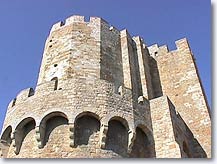| Ramblin' On with Pat Middleton |
|
|
| Author, Pat Middleton
continues her journey to find great waterway cruises for greatriver.com
travelers!
The Rhone River Delta The Camargue
|
Gypsies of the
Camargue
Anyone who has read, "Bury Me Standing," the best-selling gypsy history will find a treasure of living history in the gypsy culture of Stes. Maries-de-la-Mer. The gypsies have a long history in Europe. It is estimated that they left India as a group of nomads around 900 a.d. reaching Persia in 950 and Petit Egypt 1230. By 1370 the gypsies, or GITANs as they are called in France, were totally enslaved in Romania. They arrived in Stes. Maries-de-la-Mer in 1438 and Spain in 1539. While most of the family groups still speak a mix of Romanian and Sanskrit, those from Spain speak Spanish -- the Catholics cut out their tongues during the Inquisition so they couldn’t speak Romanian.
Typically, the gypsies were travelers, with the family names of Tinker, Tartar or Traveler in Ireland and England. White-skinned Europeans were called Voyeurs, Gitans in France or Spain, Tzigane in Romania. They might be jugglers, trapeze artists, puppeteers, or train animals for the circus. In France many gypsies are still circus people. A miniature 3-ring circus model in one museum wagon took 6 years to complete. The museum curator was a man with a passion. I was reminded of how few private
museums one finds now in the US. He was sorry to see the wagon era end. These
were true gypsies he explained. " Now," he sighed, " its just young kids coming in trailers and
motor homes to party." The little community of faith landed safely on the shore at the present Stes. Maries-de-la-Mer from which Lazarus made his way to Marseilles to evangelize and the Marys stayed in the area between Taracson/Arles and the Camargue. The 9th century church was built to accommodate pilgrims visiting the shrine at the site where the Marys were buried. Recent excavations of the crypt indicate that, indeed, the bones are those of an Egyptian woman from about the 1st century. An elaborate gypsy festival and pilgrimage is held about the 3rd weekend in
May. Continue, part 4 of 5
|
[ Camargue Overview ]
[ Map of Camargue ] [ The
Gardians ] [The Gypsies ]
[ Birding ] [
Agriculture ] [Travel & Tourism
Info ]
Return to [ Waterway
Cruises ]
Return to [ The Mississippi River Home Page
]



 The gypsies
converge upon Stes Maries-de-la-Mer during the annual May pilgrimage. This
nomadic
culture, much maligned, is seldom welcomed to great cathedrals and
law-abiding communities. Yet in Les Stes. Maries-de-la-Mer they are welcomed to the
9th century fortified Romanesque church and the St. Sarah
Crypt. Sarah, the patron saint of the gypsy
culture, was the housemaid for Mary-Jacobe and Mary-Salome and Lazarus.
According to local legend, when the Maries and Lazarus were sent out
to sea in a small boat during the persecution of Christians by the Jews, they
left Sarah behind. She cried out and one of the Mary's threw her coat onto the
water. Sara stepped onto the coat and it bore her to the boat.
The gypsies
converge upon Stes Maries-de-la-Mer during the annual May pilgrimage. This
nomadic
culture, much maligned, is seldom welcomed to great cathedrals and
law-abiding communities. Yet in Les Stes. Maries-de-la-Mer they are welcomed to the
9th century fortified Romanesque church and the St. Sarah
Crypt. Sarah, the patron saint of the gypsy
culture, was the housemaid for Mary-Jacobe and Mary-Salome and Lazarus.
According to local legend, when the Maries and Lazarus were sent out
to sea in a small boat during the persecution of Christians by the Jews, they
left Sarah behind. She cried out and one of the Mary's threw her coat onto the
water. Sara stepped onto the coat and it bore her to the boat.

